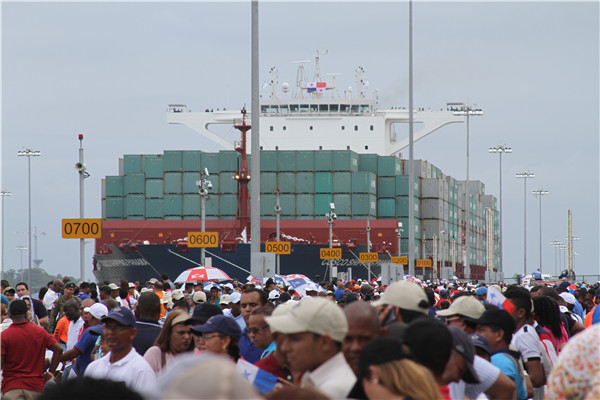
COSCO Shipping Panama becomes the first ship to make transit across the newly expanded Panama Canal, entering the Atlantic side locks after 8am on Sunday. The Panama Canal expansion is a 9-year, $5.4 billion project that can accommodate longer, larger-capacity ships. AMY HE / CHINA DAILY
A Chinese container ship became the first vessel to make the inaugural passage through the newly expanded Panama Canal, a nine-year, $5 billion project that authorities hope will usher in a new era of global commerce at a time when the shipping industry is facing one of the worst slumps in history.
The COSCO Shipping Panama crossed the 50-mile canal shortly after 8 am on Sunday morning. It had set sale from the Greek Port of Piraeus two weeks prior and once it reached Panama transited the Agua Clara Locks on the Atlantic side of the canal in the morning and the Cocoli Locks in the afternoon.
Over 5,000 people attended the inaugural ceremony, which included the Panamanian president and government officials, the administrator of the Panama Canal Authority, a COSCO Shipping delegation led by the company's chairman Xu Lirong, as well as workers who helped build the canal project and local residents.
Xu said that the expansion is not only a major development for the canal but a "milestone of the global shipping industry". The shipping company is the largest in the world in terms of carrying capacity and one of the canal's biggest users, so being the first to transit the expanded canal is "not only an honor for the vessel and its crew," but for all of the company and its employees, he said.
COSCO Shipping is the newly formed company after Cosco Group and China Shipping Group merged earlier this year, and the Panama vessel was loaded with containers bearing the names of "Cosco" and "China Shipping" onboard.
The company said that after the new expanded canal opens, it will be able to send many of its new Panamax ships it owns, which include large container and bulk carriers as well as tankers that can now pass through the wider lane. COSCO Shipping deploys its larger ships to enhance services to the U.S. east coast, it said.
The COSCO Shipping Panama, launched in January 2016, is a new shipping vessel that measures 984 feet long and 158 feet in beam. It carries a capacity of 9,472 TEUs (twenty-foot equivalent unit) and was named in honor of the inaugural visit as well as the people of Panama, according to maritime news site Marine Link.
The inaugural ceremony marks the end of the largest construction project undertaken at the Panama Canal since its opening in 1914. The expansion doubles the canal's cargo capacity, adding a third lane to accommodate larger ships that can carry about 14,000 containers, up from the 5,000 that ships can previously carry.
The expansion is meant to make the Panama Canal more competitive after the global shipping industry was impacted in the aftermath of the global financial crisis in 2008.
Though the number of ship transits through the Panama Canal increased 3.7 percent last year compared to the year prior, increase in cargo had grown only 1 percent compared to the 7 percent previously, according to the Wall Street Journal.
The canal had also lost about 10 to 15 percent of annual revenue to the Suez Canal in Egypt and authorities hope that they can win back shipping lines that switched over to the Suez Canal or used west coast ports in the U.S., anticipating that revenue will increase 16 percent next year.
The opening of the third lane will shorten the journey that ships take from Asia to the Americas at a time when approximately one-third of all Asia-to-America trade happens through the canal, which was built in the early 20th century by the U.S..
The expanded canal's new locks are as tall as an 11-story building and 50 feet wider than the old ones, and can accommodate ships up to 1,200 feet long, 160 feet wide, and 50 feet deep. Water from basins are used to push ships above sea level as it transits through chambers in the canal.


















































